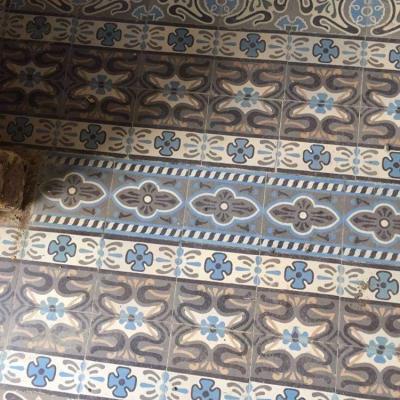2.7m2 to 4.7m2 of Belgian Art Nouveau ceramic tiles
Reclaimed from a town house in Namur, Belgium and now fully restored and ready to relay, we present a small antique Belgian ceramic of 2.7m2 / 8.9 sq ft.
The tiles bear the reverse inscription rings and stamp of 'M' identifying them as having been produced by Carrelages Céramiques de Chimay, Maufroid Freres & Soeur, Rue Poncet, Bourlers, Henegouwen, Belgium, who later became: S.A. La Céramique de Bourlers.
Maufroid Freres et Soeur traded as such between 1879 and 1912, so the tiles were produced pre-1912. The lush and fluid art nouveau design of the floor, in its cool palette of greys, off-white, charcoal, blue and green, would likely narrow the date of production to between 1900 and 1912.
98 tiles, totalling 2.7m2 / 29 sq ft. and +/- 16.5cm / 6.5 inches square, they have restored well; a quality ceramic, they display a rich patina where colours are crisp and consistent and there is no surface wear. Some tiles display small groutable chips or edge nibbles, expected of a floor between 113 years and 125 years old, but adding to the lovely antique patina and charm of the floor. Ideal for a small entrance porch, a toilet or as a decorative feature within a larger tile lay.
We also have c.60 blue lozenge-themed antique border tiles, totaling 1.6m2 / 17.2 sq ft, produced by the same manufacturer, which can be used to frame the floor. This would increase the surface area to c.4.3m2 / 46 sq ft. and provide for a linear length of the borders of 9.9 metres or 32.5 ft.
NOTE Antique tiles were most commonly made in single or two tile moulds. Before current computer automation methods their moulds were made by hand and the colour slips mixed by eye. Kiln temperatures could also be variable, as could the firing time. The result is that tiles often display subtle size and thickness variations and there can be tonal variations in colours, owing to the slip mixing and/or firing time. All of this makes these handmade tiles unique and adds to their charm. Some floors display their subtle variations in size and tones, some not, but when photographing we always take a random section of the floor so that it is representative of the whole. A tiler should always dry lay a section of the tiles to familiarise himself with them before starting to fix lay.
CL133 MAD13-1





